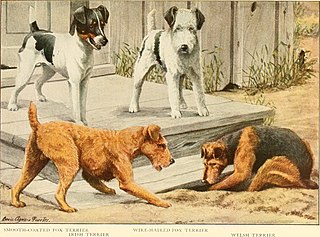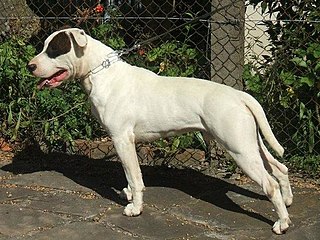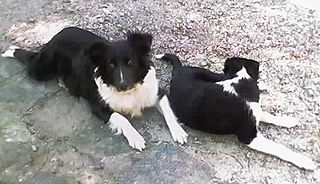
Terrier is a type of dog originally bred to hunt vermin. A terrier is a dog of any one of many breeds or landraces of the terrier type, which are typically small, wiry, game, and fearless. There are five different groups of terrier, with each group having different shapes and sizes.

The Jack Russell Terrier is a British breed of small terrier. It is principally white-bodied and smooth-, rough- or broken-coated, and can be any colour.

The Affenpinscher is a German breed of small toy dog of Pinscher type. Originally developed as a mouser, the Affenpinscher is now commonly found as a companion worldwide.

Fox Terriers are two different breeds of the terrier dog type: the Smooth Fox Terrier and the Wire Fox Terrier. Both of these breeds originated in the 19th century from a handful of dogs who are descended from earlier varieties of British terriers, and are related to other modern white terrier breeds. In addition, a number of breeds have diverged from these two main types of fox terrier and have been recognised separately, including the Jack Russell Terrier, Miniature Fox Terrier and Rat Terrier. The Wire and Smooth Fox Terriers share similar characteristics, the main differences being in the coat and markings. They have been successful in conformation shows, more prominently in America than their homeland.

A spaniel is a type of gun dog. Spaniels were especially bred to flush game out of denser brush. By the late 17th century, spaniels had been specialized into water and land breeds. The extinct English Water Spaniel was used to retrieve water fowl shot down with arrows. Land spaniels were setting spaniels—those that crept forward and pointed their game, allowing hunters to ensnare them with nets, and springing spaniels—those that sprang pheasants and partridges for hunting with falcons, rabbits and smaller mammals such as rats and mice for hunting with greyhounds. During the 17th century, the role of the spaniel dramatically changed as Englishmen began hunting with flintlocks for wing shooting. Charles Goodall and Julia Gasow (1984) write that spaniels were "transformed from untrained, wild beaters, to smooth, polished gun dogs."

The Fila Brasileiro is a Brazilian breed of large working dog of mastiff type.

The South Russian Ovcharka or South Russian Shepherd Dog is breed of flock guardian dog. It developed in the areas of the Russian Empire and the Soviet Union that are now Ukraine and southern Russia, and is thought to derive from cross-breeding between local dogs of the Russian steppes and long-haired shepherd dogs brought to the area from Spain in the late eighteenth century together with Merino sheep. These may have been similar in appearance to the present-day Gos d'Atura Catala.

The Ratonero Bodeguero Andaluz is a Spanish breed of dog of the terrier type. Its name reflects its main occupation: hunting rats and mice hidden between barrels in the wineries of Andalusia in Spain. It was recognised as an indigenous Spanish breed in 2000 by the Spanish Ministry of Agriculture and by the Spanish Kennel Club, the Real Sociedad Canina de España.
Hunt Terrier refers to types of terrier dogs that were attached to British "hunts", horse-oriented social clubs devoted to chasing the red fox on horseback, following packs of hounds. The hunt terrier was kept for a variety of reasons, such as rat control around stables and kennels, and to run with the hounds to flush the fox from small hiding places. It might also be expected to flush foxes from underground dens, or to act as a lurcher. They tended to be white in colour so as to be more easily seen by the hunter, but they could be any colour.

The Chilean Terrier is the first breed of dog from Chile. The breed dates back to the late 19th century, resulting from the crossing of the Smooth Fox Terrier with the Ratonero Bodeguero Andaluz. This dog is recognised by the Kennel Club of Chile (KCC), but is not recognized by the FCI yet. Since 2011, the breed is classified into Group 3 of Alianz Canine Worldwide (ACW).

The Transylvanian Hound, also known as the Transylvanian Scent Hound or Hungarian Hound, is a Hungarian breed of scent hound used primarily for hunting. It originated in the former Kingdom of Hungary in the historical region of Transylvania, which is now part of Romania. It is strong and of medium size, characterized by a black body with tan and sometimes white markings on the muzzle, chest and extremities, and distinctive tan eyebrow spots. It has a high-pitched bark for a dog of its size. The breed was rescued from extinction by focused breeding efforts in the late twentieth century. There were formerly two varieties, the tall and the short, developed for different kinds of hunting in the Middle Ages. Only the tall variety survives today.

The Portuguese Sheepdog is a medium-sized breed of dog of the herding dog type, and is one of the indigenous regional dogs of Portugal. The Portuguese name refers to Serra de Aires, a mountain near Montforte in the Alentejo region. The breed is nicknamed cão macaco for its furry face and lively attitude.

The Rastreador Brasileiro is a large breed of dog from Brazil, first recognised by the Fédération Cynologique Internationale in 1967, but an outbreak of disease, compounded by an overdose of insecticide, wiped out the breed's entire breeding stock. The FCI and the Brazilian Kennel Club then declared the breed extinct in 1973 and delisted it. Since then, efforts have been made to re-create the breed. The Rastreador Brasileiro is a hunting dog of the scenthound type. The breed is also known by the names Urrador or Urrador Americano, in reference to the American (U.S.) coonhounds in its background. In 2013, the Brazilian Kennel Club (CBKC) officially re-recognized the breed. The FCI Breed Standard was produced in 2019.

The Ratonero Valenciano, also known as the Gos Rater Valencià, is a breed of dog that originates in Spain. Recognised by the Real Sociedad Canina de España in 2004, it has had recent success with a member of the breed winning the Spanish National Dog Show in 2011. It is a traditionally docked breed. In 2022, the FCI finally recognised the breed, naming it rather "Terrier" than "Ratter".

The Dogue Brasileiro is a mastiff-type working dog breed originating in Brazil. It is neither recognized by the Fédération Cynologique Internationale (FCI) nor the American Kennel Club (AKC). However, it has the official Brazilian recognition by the Brazilian Confederation of Cynophilia (CBKC) where it belongs to the Group 11 – Breeds not recognized by the FCI.
A ratter is any dog used for catching and killing rats and similar vermin. Specialized rat-catching breeds are found in many countries. A typical ratter is small to medium-sized and has a short and smooth coat, however a wide range of dog breeds and landraces may be used. The use of ratting dogs is widely considered to be the most environmentally friendly, humane and efficient methods of exterminating rodents. Ratting dogs are considered more efficient than domestic cats.
The warren hounds are a group of Mediterranean rabbit-hunting dog breeds. In Spanish, this type of breed is called podenco, in Catalan coniller, and in Portuguese podengo.

The Gaucho Sheepdog (Portuguese: Ovelheiro gaúcho) is a dog breed that originated in the Pampas, Brazil. The breed is not recognized by the Fédération Cynologique Internationale (FCI), but it has been recognized by the CBKC, a Brazilian kennel club affiliated with FCI. Dogs of this breed are often characterized as sturdy and agile, which makes them suitable for herding activities. The Gaucho sheepdog is widely used for herding sheep and other livestock, especially in the southern region of Brazil.

Pampas Deerhound is a Brazilian breed of hunting dog; it is also found in Argentina and Uruguay. It is common in Brazil, where it was first recognized by a national kennel club. The dogs were used to track, capture, and hunt deer, and thus earned the name Pampas Deerhound. It is still a widely preferred hunting companion to track other animals, such as wild boars.
















